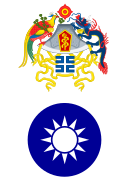Republic of China (1912–49)
| Republic of China |
中華民國
Chunghwa Minkuo
|
|
|
|
|
Anthem
(1937–49)
|
|
Location and maximum extent of the territory claimed by the Republic of China.
|
| Capital |
|
| Demonym |
Chinese |
| Government |
Unitary semi-presidential republic
|
| President |
|
| • |
1912 |
Sun Yat-sen (provisional) (first) |
| • |
1949 |
Li Zongren (acting) (last) |
| Premier |
|
| • |
1912 |
Tang Shaoyi (first) |
| • |
1949 |
He Yingqin (last) |
| Legislature |
|
| • |
Upper house |
National Assembly |
| • |
Lower house |
Legislative Yuan |
| Historical era |
20th century |
| • |
Monarchy abolished |
10 October 1911 |
| • |
Republic of China proclaimed |
1 January 1912 |
| • |
Nationalist rule from Nanking |
18 April 1927 |
| • |
Start of Second Sino-Japanese War
|
7 July 1937 |
| • |
Admitted to the United Nations
|
25 October 1945 |
| • |
Constitution adopted |
25 December 1947 |
| • |
Fall of Nanjing |
21 April 1949 |
| • |
People's Republic of China proclaimed |
1 October 1949 |
| • |
Seat of government moved to Taipei
|
7 December 1949 |
| Area |
| • |
1912 |
11,077,380 km² (4,277,000 sq mi)
|
| Population |
| • |
1912 est. |
432,375,000 |
|
Density |
39 /km² (101.1 /sq mi) |
| • |
1920 est. |
472,000,000 |
|
Density |
42.6 /km² (110.4 /sq mi) |
| • |
1930 est. |
489,000,000 |
|
Density |
44.1 /km² (114.3 /sq mi) |
| • |
1948 est. |
489,000,000 |
|
Density |
44.1 /km² (114.3 /sq mi) |
| • |
1949 est. |
541,670,000 |
|
Density |
48.9 /km² (126.6 /sq mi) |
| Currency |
|
|
|
| Today part of |
|
| a. |
1912 and 1927–49 (although see footnote c immediately below). |
| b. |
1912–27. |
| c. |
Chongqing served as capital during the Second Sino-Japanese and Pacific Wars (1937–46). |
| Populations from http://www.populstat.info/Asia/chinac.htm |
The Republic of China was a state in East Asia from 1912 to 1949. It largely occupied the present-day territories of China, Taiwan, and, for some of its history, Mongolia. As an era of Chinese history, it was preceded by the last imperial dynasty of China, the Qing dynasty, and ended with the Chinese Civil War. After the war, the losing Kuomintang retreated to the island of Taiwan to found the modern Republic of China, while the victorious Communist Party of China established the People's Republic of China on the Mainland.
The Republic's first president, Sun Yat-sen, served only briefly. His party, then led by Song Jiaoren, won a parliamentary election held in December 1912. However the army led by President Yuan Shikai retained control of the national government in Beijing. After Yuan's death in 1916, local military leaders, or warlords, asserted autonomy.
In 1925, the Kuomintang started establishing a rival government in the southern city of Guangzhou. The economy of the north, overtaxed to support warlord adventurism, collapsed in 1927–28. General Chiang Kai-shek, who became KMT leader after Sun's death, started his military Northern Expedition campaign in order to overthrow the central government in Beijing. The government was overthrown in 1928 and Chiang established a new nationalist government in Nanjing. He later cut his ties with the communists and expelled them from the KMT.
...
Wikipedia




